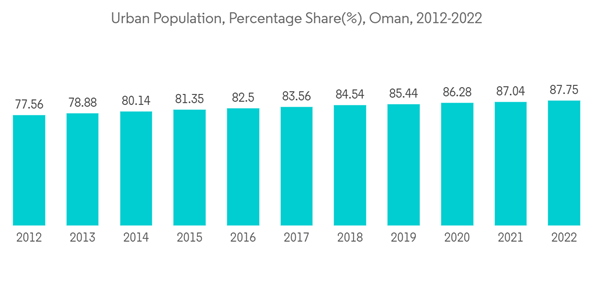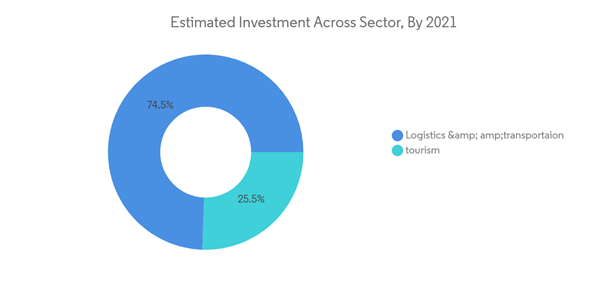The Oman Transportation Infrastructure Construction Market size is estimated at USD 2.38 billion in 2024, and is expected to reach USD 3.12 billion by 2029, growing at a CAGR of greater than 5.65% during the forecast period (2024-2029).
COVID-19 severely impacted the overall construction sector in Oman and transportation infrastructure construction does not have exception for it. Construction activity was slowed down due to difficulty in the supply chain and social distancing factors. As Oman is Oil oil-based economy, a fall in oil prices during the Covid period slowed down the economic activity in Oman. This economic slowdown impacted negative growth in the Oman Transportation Infrastructure Construction Market in the short term. The speedy recovery has been seen in infrastructure construction since 2021.
Rapid urbanization, the growing need for large transportation infrastructure capacity for oil transport, and aging existing infrastructure are some of the key driving factors for revenue growth of the Oman Transportation Infrastructure Construction Market
As the share of the urban population grows, the growth of transport infrastructure is also required to connect them to the urban areas in Oman. The growing urban population boosting the demand for transportation infrastructure construction. Existing infrastructures in developed countries must be improved to improve resilience, improve the environment, and reduce maintenance costs.
The government of Oman is making more investments in transportation infrastructure to cater transportation needs of the urban population. This is creating lucrative opportunities in the infrastructure segment of the country. Hence growing urban population boosts the revenue growth of the Oman Transportation Infrastructure Market.
The Sultanate of Oman is executing a successful model of economic diversification, notably, the country’s trade liberalization in goods and services. Oman pursued an active plan of development that focuses on diversification, manufacturing, and privatization to diminish the contribution of the oil sector to the GDP to 9%. The tourism and hydrocarbon industries have become the main components of the government’s economic diversification strategy.
In the manufacturing sector, Tanfeedh (Economic Diversification Plan) was slated for new investments by 2020, although this was brought to a standstill by the pandemic later. The key sub-sectors include the petrochemicals, metals, materials, and the food and energy sectors. Oman’s tourism sector is mostly untapped. The Travel and Tourism Competitiveness Index of Oman in 2019 was 58 globally. Although the pandemic heavily impacted the tourism sector in 2020, an increase in infrastructure spending plans helped the sector recover over 2021‑2022.
Within logistics, the Omani government is positioning Duqm as a major industrial and business zone in the region. One of the objectives of the Special Economic Zone Authority in Duqm is to develop the central arid region of the country and create ample space for international and local investors to build world-class projects. This will help achieve promising growth in the Omani economy, and at the same time, strengthen the country's position at the international level.
This product will be delivered within 2 business days.
COVID-19 severely impacted the overall construction sector in Oman and transportation infrastructure construction does not have exception for it. Construction activity was slowed down due to difficulty in the supply chain and social distancing factors. As Oman is Oil oil-based economy, a fall in oil prices during the Covid period slowed down the economic activity in Oman. This economic slowdown impacted negative growth in the Oman Transportation Infrastructure Construction Market in the short term. The speedy recovery has been seen in infrastructure construction since 2021.
Rapid urbanization, the growing need for large transportation infrastructure capacity for oil transport, and aging existing infrastructure are some of the key driving factors for revenue growth of the Oman Transportation Infrastructure Construction Market
Oman Transportation Infrastructure Construction Market Trends
Growing urban population driving the growth of transportation infrastructure.
Growing transportation infrastructure investment is supported by the rapid growth in the urban population. As per the World Bank, in 2022 the urban population of Oman reached 4.4 million. In 2022, the share of the urban population has reached 87.75%.As the share of the urban population grows, the growth of transport infrastructure is also required to connect them to the urban areas in Oman. The growing urban population boosting the demand for transportation infrastructure construction. Existing infrastructures in developed countries must be improved to improve resilience, improve the environment, and reduce maintenance costs.
The government of Oman is making more investments in transportation infrastructure to cater transportation needs of the urban population. This is creating lucrative opportunities in the infrastructure segment of the country. Hence growing urban population boosts the revenue growth of the Oman Transportation Infrastructure Market.
Sultanate's Economic Diversification Plan (Vision 2040) to provide new growth to the market
Oman’s economy heavily relies on revenue from oil, a shift is required to diversify sources of income by promoting investments in targeted sectors. The government has focused on pursuing this objective by boosting the contribution of the five target sectors in the Ninth Five Year Plan, including logistics, manufacturing, tourism, fisheries, and mining, as well as moving forward with key strategic projects.The Sultanate of Oman is executing a successful model of economic diversification, notably, the country’s trade liberalization in goods and services. Oman pursued an active plan of development that focuses on diversification, manufacturing, and privatization to diminish the contribution of the oil sector to the GDP to 9%. The tourism and hydrocarbon industries have become the main components of the government’s economic diversification strategy.
In the manufacturing sector, Tanfeedh (Economic Diversification Plan) was slated for new investments by 2020, although this was brought to a standstill by the pandemic later. The key sub-sectors include the petrochemicals, metals, materials, and the food and energy sectors. Oman’s tourism sector is mostly untapped. The Travel and Tourism Competitiveness Index of Oman in 2019 was 58 globally. Although the pandemic heavily impacted the tourism sector in 2020, an increase in infrastructure spending plans helped the sector recover over 2021‑2022.
Within logistics, the Omani government is positioning Duqm as a major industrial and business zone in the region. One of the objectives of the Special Economic Zone Authority in Duqm is to develop the central arid region of the country and create ample space for international and local investors to build world-class projects. This will help achieve promising growth in the Omani economy, and at the same time, strengthen the country's position at the international level.
Oman Transportation Infrastructure Construction Industry Overview
The report covers major national and international players operating in Oman's transportation infrastructure construction market. The market is fragmented with major players holding the lower market share. The Oman construction market is highly competitive with the presence of major international players. Galfar Engineering and Contracting SAOG, Desert Line Group, STRABAG SE, Bechtel, Khalid Bin Ahmed & Sons LLC are some of the key market player operating in market. The market may present lucrative opportunities for growth during the forecast period, which is expected to further drive market competition.Additional Benefits:
- The market estimate (ME) sheet in Excel format
- 3 months of analyst support
This product will be delivered within 2 business days.
Table of Contents
1 INTRODUCTION
4 MARKET INSIGHTS AND DYNAMICS
5 MARKET SEGMENTATION
6 COMPETITIVE LANDSCAPE
Companies Mentioned (Partial List)
A selection of companies mentioned in this report includes, but is not limited to:
- Galfar Engineering and Contracting SAOG
- Desert Line Group
- STRABAG SE
- Bechtel
- Khalid Bin Ahmed & Sons LLC
- Consolidated Contractors Company
- STFA Group
- Hill International
- Doğuş Construction*
Methodology

LOADING...










